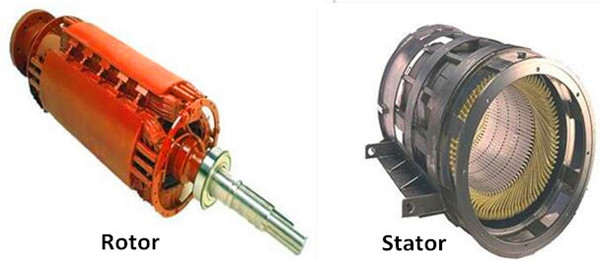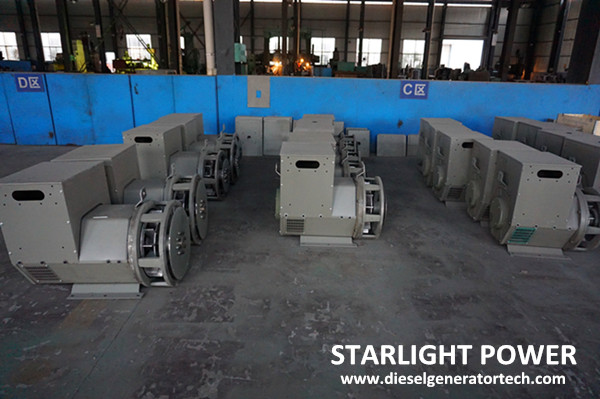An alternator is a mechanical device that converts other forms of energy into electrical energy. Alternator is generally composed of rotor, stator, rectifier and end cover.
The rotor is composed of rotor core (or magnetic pole) winding, guard ring, center ring, slip ring, fan and rotating shaft. The function of the rotor is to generate a magnetic field. Installed inside the stator. The stator consists of stator core, wire windings, engine base, and other structural parts that fix these parts. The function of the stator is to generate alternating current.

The principle is that the stator and the rotor of the generator are connected by the bearing and the end cover, so that the rotor can rotate in the stator, and does the movement of cutting magnetic line, thus generating the induction potential, which is led out through the terminal and connected in the loop, and the current is generated.
There are many forms of generators, but their working principles are based on the law of electromagnetic induction and electromagnetic force. Therefore, the general principle of its construction is to use appropriate magnetic conductive and conductive materials to form magnetic circuits and circuits for mutual electromagnetic induction in order to generate electromagnetic power and achieve the purpose of energy conversion.
The mechanical energy of the prime mover is converted into the electrical energy output by using the electromagnetic induction principle of the magnetic force line induced by the wire cutting magnetic force line. Synchronous generator consists of stator and rotor. The stator is the armature that generates electricity, and the rotor is the magnetic pole. The stator is composed of armature iron core, uniform discharge three-phase winding, base and end cover.
The rotor is usually a hidden pole type consisting of excitation winding, iron core and shaft, guard ring, center ring and so on. The excitation winding of the rotor is energized with a direct current, producing a magnetic field close to a sinusoidal distribution (referred to the rotor field), whose effective field flux intersects the static armature winding. When the rotor rotates, the rotor magnetic field rotates with it, with each revolution, the magnetic lines cut each phase winding of the stator sequentially, and the three-phase alternating current potential is induced in the three-phase stator winding.
When the generator is operated with symmetrical load, the three-phase armature current is combined to produce a rotating magnetic field with synchronous speed. The stator magnetic field interacts with the rotor magnetic field to generate braking torque.
The three-phase windings of the alternator stator are nested in the stator slots of the generator according to a certain rule, and are mutually different by 120° electrical angle. When the rotor field winding is connected to the DC power source, the claw pole of the rotor is magnetized to N pole and S pole. The magnetic field line starts from the N pole, enter the stator core through the small air gap between the rotor and the stator, and finally return to the S pole through the air gap.

Usage specification
(1) The grounding polarity of the battery must be the same as that of the alternator ground. The consequence of not using according to the specification is that the diode is damaged due to the large current discharge of the diode.
(2) When the six diodes of the rectifier are connected to the stator winding, it is absolutely forbidden to check the insulation of the alternator with a megger or 220V AC power supply. Otherwise, the diode is easily broken down and damaged.
(3) After the engine is turned off, the ignition switch should be turned off. If the flame is not turned off in time, the battery will continue to discharge, which will affect the magnetic field and shorten the battery life.
(4) When the alternator is running, it is not allowed to use the fire test method to check whether it generates electricity. Otherwise, it is easy to damage diode and electronic components.
(5) The regulator must be the same as the alternator in the form of iron, otherwise the alternator will not be able to output voltage due to no magnetic field current. And the voltage level of the two should be the same, otherwise the charging system can not work properly.
(6) If the alternator is not generating electricity or the charging current is small, the fault should be eliminated in time, and the wire connection between the alternator and the battery should be firm. Otherwise, it is easy to damage diodes and electronic components.
(7) When the alternator is mounted on the engine, the center of the alternator with pulley groove and the center of the engine with pulley groove should be aligned, and the appropriate degree of triangular belt tightness should also be set.
8) When installing the V-belt early, force to pry the front cover of the alternator. Otherwise, it will crush the element.
Synchronous generator belongs to Alternator (AC generator), and the stator winding is the same as the asynchronous generator. Its rotor rotation speed is the same as that of the rotating magnetic field generated by the stator winding, so it is called a synchronous generator. Because of this, the current of the synchronous generator is ahead of the voltage in phase, that is, the synchronous generator is a capacitive load. For this reason, in many cases, synchronous generators are used to improve the power factor of the power supply system.
Copyright © Guangxi Dingbo Generator Set Manufacturing Co., Ltd. All Rights Reserved | Sitemap
Update cookies preferences